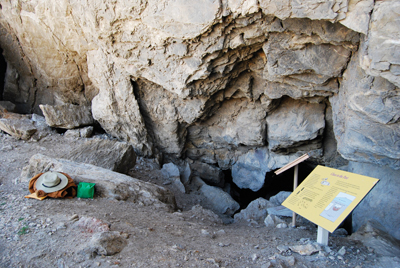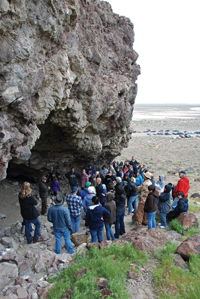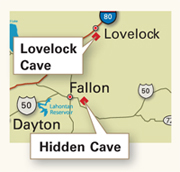Prehistoric Storage (VIDEO)
Prehistoric Storage (VIDEO)
Nevada’s ancient caves contain a “hole” lot of Native American history.
BY CHARLIE JOHNSTON | JULY/AUGUST 2011

When ancient Lake Lahontan was at its peak, it filled the lower valleys of northwestern Nevada to depths of up to 900 feet and had a surface area of more than 8,500 square miles. The enormous lake’s waves and strong currents scoured hillsides and gouged many caves along its shores.
When water levels started to decline about 10,000 years ago, many of the recently dry caves attracted the attention of Nevada’s early native inhabitants, who used them for storage. Two such grottos—Hidden Cave above the Carson Sink near Fallon and Lovelock Cave above the Humboldt Sink near Lovelock—offer glimpses into the lives of the people who used them for thousands of years.
The ancestors of today’s Northern Paiutes were using Hidden Cave as long as 9,000 years ago, with the heaviest period of use starting around 4,000 years ago. What makes the cave so special is that people used it to store their valuables, whereas many archaeological sites more or less equate to ancient dumps. Instead of food leftovers, debris, and cooking fire remnants, researchers have found tools, jewelry, and even woven items in the cave. (View of an incredible video about Hidden Cave here.)

Rediscovered in the 1920s by four Fallon boys, Hidden Cave has been the subject of three scientific excavations since. Many of the artifacts found in those excavations can be viewed at Fallon’s Churchill County Museum, which also offers free, twice-monthly weekend tours of the cave.
Those tours (the second and fourth Saturday of each month) are often attended by students from Nevada colleges and universities. Hal Starratt, a professor of anthropology at Western Nevada College in Carson City, has taken his students to the site every semester for about a decade. Many of Starratt’s students bring their families along for the twice-yearly trips. “The more people that know about these kinds of places, the more people will take care of them,” Starratt says.
Lovelock Cave was rediscovered in the early 1900s by guano miners whose clumsy digging destroyed many of the cave’s relics before scientific excavation commenced. Archaeological investigations from 1912 to the ’70s uncovered numerous artifacts, including 11 tule duck decoys dating to more than 2,000 years old. Ancient tools and woven items such as sandals and baskets were also uncovered in the cave.
Like Hidden Cave to the south, Lovelock Cave was used as a storage site rather than a dwelling. Artifacts from the cave can be viewed at the Marzen House Museum in Lovelock and Winnemucca’s Humboldt Museum.
Paiute legend tells of a battle at Lovelock Cave in which a group of mythical cannibalistic red-haired giants called the Sai’i were driven into the cave and killed by the Paiutes.
If you go …
 Hidden Cave
Hidden Cave
Churchill County Museum
1050 S. Maine St., Fallon
ccmuseum.org
775-423-3677
Lovelock Cave
Marzen House Museum
25 Marzen Ln., Lovelock
loverslock.com
775-273-4949
